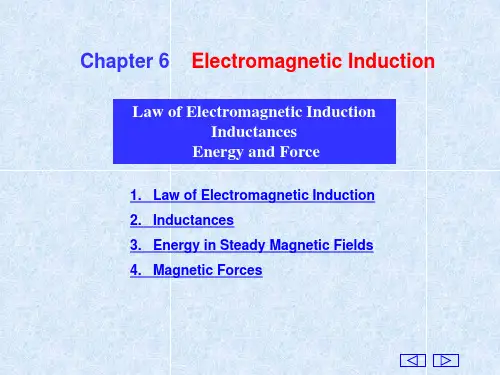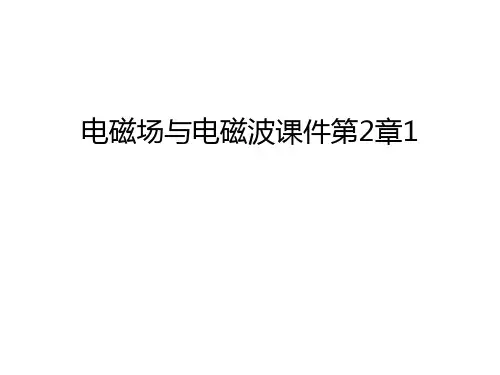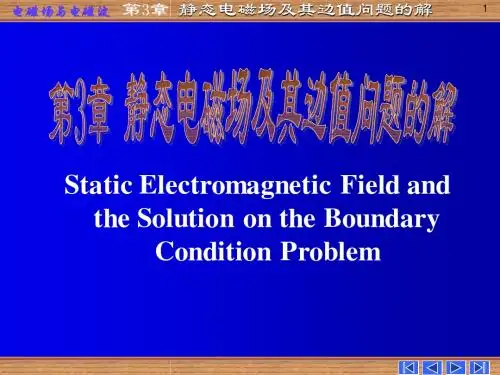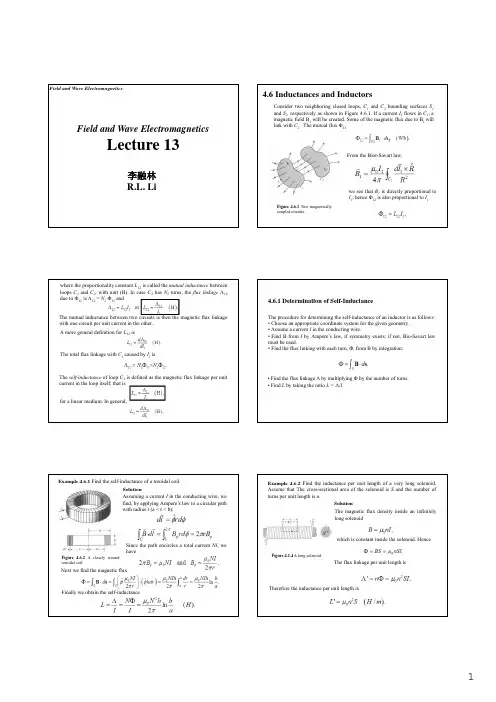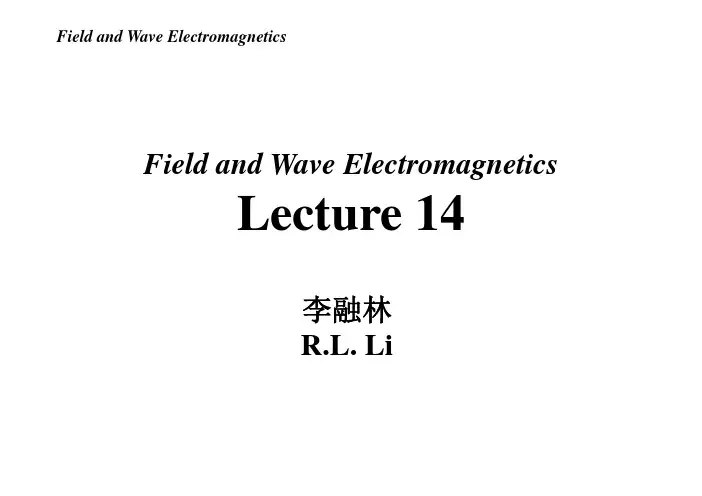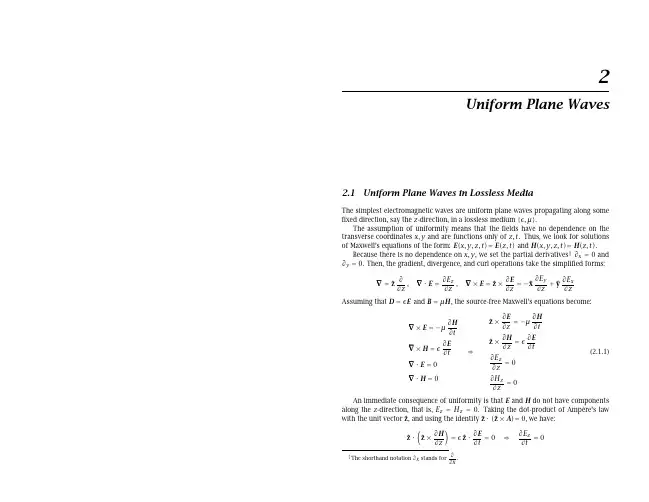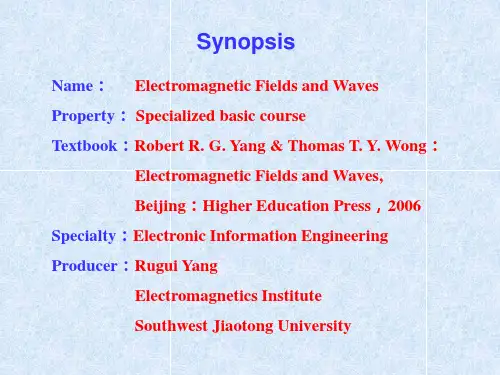电磁场与电磁波课件(英文版)
- 格式:ppt
- 大小:1.46 MB
- 文档页数:24
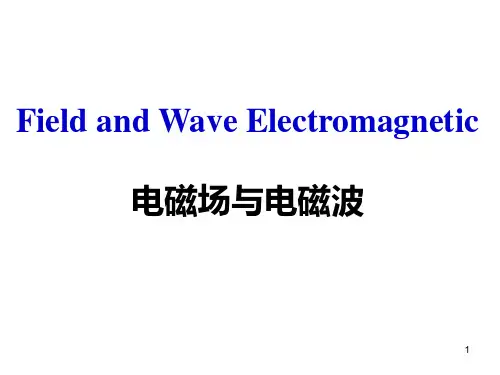
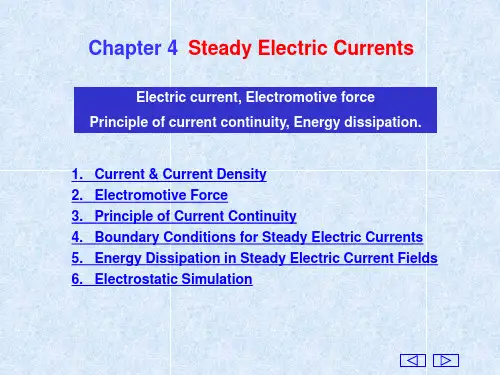
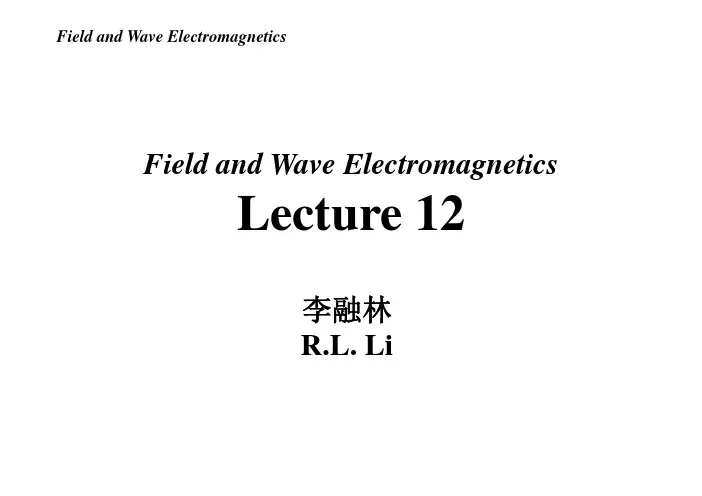
Field and Wave ElectromagneticsField and Wave ElectromagneticsLecture 12李融林R.L. Li4.5Magnetic Fields in Materials and MagneticCircuitsBehavior of Magnetic MaterialsNonmagnetic if(Vacuum)Diamagnetic,if(Silver,Lead,Copper,Water)Paramagnetic, if(Air, Aluminum)Ferromagnetic, if(Cobalt, Nickel, Iron, Silicon iron, Mumetal)The orbiting electrons cause circulating currents and form microscopic magnetic dipoles.In the absence of an external magnetic field the magnetic dipoles of the atoms of most materials have random orientations,resulting in no net magnetic moment.The application of an external magnetic field causes both an alignment of the magnetic moments of the spinning electrons and an induced magnetic moment due to a change in the orbital motion of electrons.4.5.1 Magnetization and Equivalent Current DensitiesWe define a magnetization vector,M ,aswhich is the volume density of magnetic dipole moment. The magnetic dipole moment d m = M dv’will produce a vector magnetic potential(Note thatfor a magnetic dipole of moment .)Usingwe can rewrite d A aswhere V’is the volume of the magnetized material. We now use the vector identityto rewriteThe following vector identity enables us to change the volume integral of the curl of a vector into a surface integral:where F is any vector with continuous first derivatives.Proof: Applying divergence theorem to (F x C), where C is a constant vector, we haveSinceandwe haveWe havewhere is the unit outward normal vector from ds’and S’is the surface bounding the volume V’.The effect of the magnetization vector isequivalent to both a volume current densityand a surface current densityThe problem of finding the magnetic flux density B caused by a given volume density of magnetic dipole moment M is then reduced to finding the equivalent magnetization current densities J m and J ms .Figure 4.5.1The cross-sectionof a magneticmaterial.Example4.5.1Determine the magnetic flux density on the axis of a uniformly magnetized circular cylinder of a magnetic material.The cylinder has a radius b, length L,and axial magnetization .Figure4.5.2A uniform magnetized circular cylinder.SolutionSince Mis a constant,The equivalent magnetization surface current density on the side wallisThe magnet is then like a cylindrical sheet with a surface current density of M(A/m).To find B at P(0,0,z),we consider a differential length dz’with a current andobtain4.5.2 Equivalent Magnetization Charge DensitiesIn a current-free region we may define a scalar magnetic potential V m , from which the magnetic flux density B can be found as . In terms of magnetization vector Mwe may write the scalar magnetic potentialIntegrating this equation over a magnetized body carrying no current, we have We know the gradient of 1/Rwith respect to the primed coordinates isHence(Note thatfor a magnetic dipole of moment.)Recalling the vector identityWe obtainwhere is the outward normal to the surface element ds’.We can conclude that, for field calculation,a magnetized body may be replaced by an equivalentmagnetization surface charge densityρms and an equivalent magnetizationvolume charge densityρmsuch that4.5.3 Boundary Conditions for Magnetostatic FieldsBoundary Condition for BApplying to a small pillbox: the normal component of B is continuous across an interface;For linear media, B 1= µ1H 1 and B 2= µ2H 2Boundary Condition for HSimilarly, applying to a small rectangular closed path, we have orWhere is the outward unit normal from medium 2at the interface .Thus the tangential component of the H field is discontinuous across an interface where a free surface current exists.When the conductivities of both media are finite,current are defined by volume current densities and free surface currents do not exist on the interface.Hence J s =0,and the tangential component of H is continuous across the boundary of almost all physical media;it is discontinuous only when an interface with an ideal perfect conductor or a superconductor is assumed.Figure 4.5.3Boundary condition for H .Example 4.5.2Two magnetic media with permeabilities µ1and µ2have a common boundary,as shown in Figure 4.5.4.Determine the magnitude and the direction of the magnetic field intensity at point P 2in medium 2.SolutionFigure 4.5.4Boundary conditions for Hand B.The desired unknown quantities are H 2andα2.Continuity of the normal component of BfieldrequiresThe tangential component of H field is continuous.WehaveDivision of the second equation by the first equation giveswhich describes the refraction property of the magnetic field.If medium 1is nonmagnetic and medium 2is ferromagnetic,then µ2>>µ1and,α2will be nearly 90degrees.If medium 1is ferromagnetic medium and medium 2is air,then α2will be nearly zero.We obtainThe magnitude of H 2isExample4.5.3Find the image currents of a long straight line current I above an interface between two magnetic media with permeabilitiesµ1andµ2SolutionFigure4.5.5A long straight line current I above an interface between two magnetic media(a);Image current for medium1(b)and image current for medium2(c).Since there is no surface current at the interface which leads toUsing yieldsororSolving the equations givesForForFigure4.5.6Magnetic field lines of a long straight line current in two media.Example 4.5.4Sketch the magnetic flux lines both inside and outside a cylindrical bar magnet having a uniform axial magnetization.Figure 4.5.2A uniform magnetizedcircular cylinder.SolutionWe know that the problem of a cylindrical barmagnet could be replaced by that of amagnetization current sheet having a surfacecurrent density J ms =M 0(J m =0).It is obvious from above equations that the magnetic flux density along the axis at the end faces of the magnet is less than that at the center.Fromwe getOn the side of the magnet there is a surface current given byHence according tothe axial component of B changes by anamount equal to µ0M 0.It must be remarked that while H =B/µ0outside the magnet,H and B inside themagnet are far from being proportionalvectors in the same direction.From H =B /µ0–M ,and the fact that B/µ0along theaxis inside is less than M 0,we observe thatH and B are in opposite directions alongthe axis inside.For a long,thin magnet,L>>b,B p0~µ0M 0.From H =B/µ0–M,weobtain H p0~0.Figure 4.5.7Magnetic flux linesaround a cylindrical bar magnet.4.5.4 Magnetic CircuitsThe curl equation for magnetic fields in materials iswhere J(A/m2) is the volume density of free current.The corresponding integral form is obtained asorwhich is the Ampere’s circuital law in materials,where C is the contour bounding the surface S and I is the total free current passing through S. Ampere’s circuital law states that the circulation of the magnetic field intensity around any closed path is equal to the free current flowing through the surface bounded by the path.Ampere’s circuital law is useful on determining the magnetic field in magnetic circuits.The quantity V mmf (=NI )is called a magnetomotive force (mmf).We define reluctance R as the ratio of the magnetic voltage to the flux ;thusAmpere’s Law for an N-turn magnetic circuit becomesSimilar to Kirchhoff’s voltage law,we may write,for any closed path in a magneticcircuit,Around a closed path in a magnetic circuit the algebraic sum of ampere-turns is equal to the algebraic sum of the products of the reluctances andfluxes.Kirchhoff’s current law for a junction is consequence of. Similarly leads to. Thus we havewhich states that the algebraic sum of all the magnetic fluxes flowing out of a junction in a magnetic circuit is zero.Example 4.5.5N turns of wire are wound around a toroidal core of aferromagnetic material with permeabilityµ.Determine Bf ,in the ferromagneticcore;Hf in the core;and Hgin the airgap.Figure4.5.8Coil on ferromagnetictoroid with air gap.Applying Ampere’s circuital lawSolutionIf flux leakage is neglected,the same totalflux will flow in both the ferromagnetic coreand in the air gap.If the fringing effect ofthe flux in the air gap is also neglected,themagnetic flux density B in both the core andthe air gap will also be the same.However,because of the different permeabilities,themagnetic field intensities in both parts willbe different.Wehavewhere the f and g denote ferromagnetic and gap, respectively.In the ferromagnetic core,and, in the air gap,Ampere’s law yieldsWe haveSimilarlyIf the radius of the cross section of the core is much smaller than the mean radius of the toroid,the magnetic flux density B in the core is approximately constant,and the magnetic flux in the circuitiswhere S is the cross-sectional area of the core.where R f and R g are the reluctances of the ferromagnetic core and the air gap, respectively .Figure 4.5.9Equivalent magneticcircuit and analogous electric circuitfor toroidal coil with air gap.Therefore,or,mfmfThe reluctances are:The two loop equations areSolving these simultaneous equations, we haveExample 4.5.6Find the flux linked with coil N 1in a magnetic circuit shown in Figure 4.5.10.Figure 4.5.10A magnetic circuit.Solution.HomeworkProblems P.6-26 and P.6-27References &Acknowledgements1.M.J.Rhee’s Lectures on Electromagnetic Theory,2005.2.W.H.Hayt,J.A.Buck,Engineering Electromagnetics,7th Ed.,McGraw-Hill,2006.3.U.S.Inan,A.S.Inan,Engineering Electromagnetics,AddisonWesley Longman,2000.4. D.Cheng,Field and Wave Electromagnetics,Second Edition,Addison Wesley,1992.。

